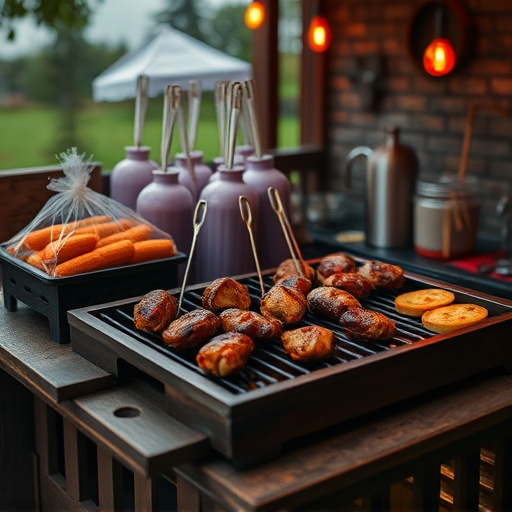BBQ brisket recipes are celebrated for their rich flavor and tender texture, achieved through slow-cooking methods like smoking at low temperatures (225-250°F) with wood chips. Crafting the perfect spice blend enhances taste, while brining and dry aging prepare the meat. Patience is key during cooking, aiming for a moist, infused brisket with desirable smoke rings. Post-cooking, charring, resting, and slicing ensure maximum tenderness and flavor. These techniques elevate your BBQ brisket recipe experience.
Unleash the flavor of a perfect BBQ brisket recipe! This guide takes you on a journey through the art of smoking one of the most coveted cuts from the grill. From understanding the brisket’s unique tenderness to mastering the science behind spice blends, we demystify every step. Learn techniques for optimal cooking, including brining and dry aging, to achieve a smoky, tender masterpiece that melts in your mouth. Discover how slow and steady cooking, precise finishing touches, and proper resting ensure a juicy, flavorful BBQ brisket experience like no other.
- Understanding Brisket: The Cut and Its Tenderness
- The Art of Smoking: Techniques for Flavor Infusion
- Spice Blend Mastery: Creating the Perfect Rub
- Pre-Cooking Preparations: Brining and Dry Aging
- Cooking Method: Slow and Steady Win the Race
- Charring and Finishing Touches: Adding Depth
- Resting and Slicing: Ensuring a Juicy, Flaky Brisket
Understanding Brisket: The Cut and Its Tenderness

Brisket, a cut of meat from the breast of a cow, is a beloved staple in barbecue culture, especially for dedicated BBQ brisket recipe enthusiasts. Its tenderness and rich flavor profile make it a prime candidate for slow-cooking methods that transform its tough connective tissues into melt-in-your-mouth delicacy.
This particular cut of beef is known for its large size and thick layers of fat, which contribute to its moistness during the cooking process. The exterior of the brisket is composed of well-marbled muscle fibers, while the interior contains a layer of fat that helps tenderize the meat as it breaks down over time. This slow breakdown is what makes BBQ brisket recipes so sought after; the end result is a succulent, flavorful piece of meat that’s hard to beat.
The Art of Smoking: Techniques for Flavor Infusion
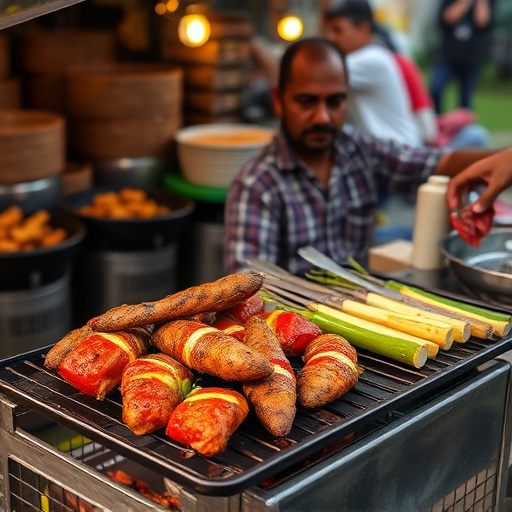
The art of smoking is a centuries-old technique that has become a cornerstone in crafting exquisite BBQ brisket recipes. It involves gently cooking meat at low temperatures over a steady flame, allowing flavors to infuse and penetrate every fiber. This process transforms ordinary brisket into a tender, smoky delicacy. Mastery lies in understanding the interplay between heat, smoke, and time.
Different smoking techniques employ various types of wood chips or chunks, each imparting unique aromas. For instance, hickory and oak are popular choices known for their robust flavors. The temperature control is crucial; slow cooking at around 225-250°F (107-121°C) ensures the brisket stays moist while the smoke gently permeates its structure, resulting in a mouthwatering BBQ brisket recipe that balances tender texture and rich, smoky taste.
Spice Blend Mastery: Creating the Perfect Rub

Creating the perfect spice blend for your BBQ brisket recipe is an art that can elevate your culinary skills to new heights. The key lies in balancing flavors – a delicate dance between heat, smoke, and tanginess. Start with a base of coarse salt and peppercorns, grinding them fresh for maximum impact. This provides a solid foundation upon which you can build more complex layers.
Consider adding smoked paprika for that essential smoky flavor, along with garlic powder, onion powder, chili powder, and a touch of cayenne pepper for heat. Don’t be afraid to experiment with other spices like cumin or coriander for a unique twist. Mix these ingredients thoroughly, adjusting quantities based on your taste preferences. The result should be a rub that clings to the brisket, infusing it with a burst of flavors during slow cooking, leading to tender, smoky perfection in every bite of your BBQ brisket recipe.
Pre-Cooking Preparations: Brining and Dry Aging
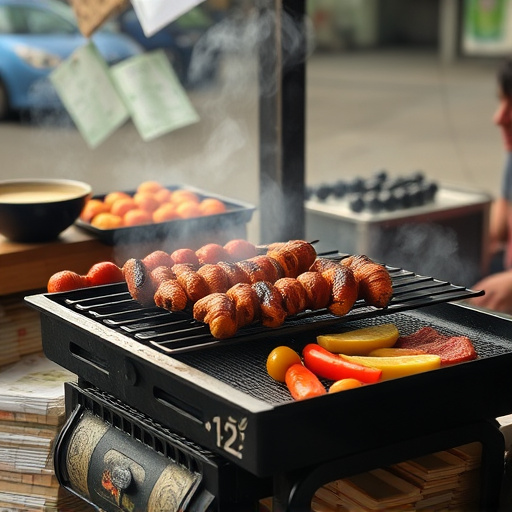
Before smoking your brisket, proper preparations are key to achieving a mouthwatering BBQ brisket recipe. Brining is an optional but highly recommended step in the process. Brine solutions, typically consisting of salt and various spices, help to break down the muscle fibers and enhance the meat’s tenderness. This technique also adds flavor and ensures the brisket stays moist during the lengthy smoking session.
Dry aging, another crucial pre-cooking method, involves leaving the meat at room temperature for several days. This process allows enzymes to naturally break down the brisket, resulting in a more flavorful and tender final product. Dry aging can take anywhere from 3-7 days, depending on personal preference and desired tenderness. These initial steps set the stage for a successful smoking session, ensuring your BBQ brisket recipe turns out perfectly smoked and deliciously seasoned.
Cooking Method: Slow and Steady Win the Race
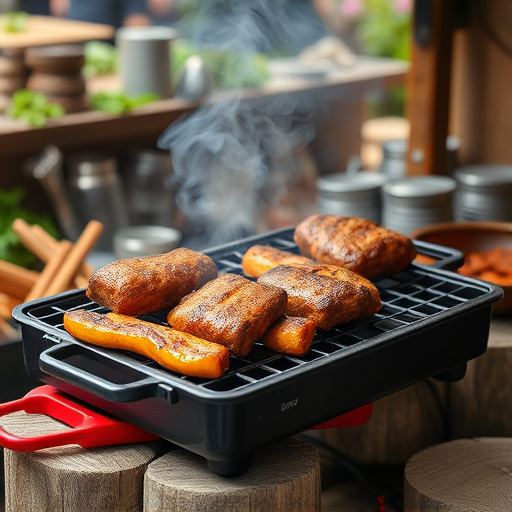
When it comes to achieving that dreamily smoky, tender brisket that melts in your mouth, the key lies in patience and a slow cooking method. Unlike rush-it-in methods like smoking or rapid roasting, slow and steady wins the race for this classic BBQ brisket recipe. By cooking the meat low and slow, typically around 135°F to 225°F (57°C to 113°C), you allow the natural juices to remain trapped within the fibers, ensuring an incredibly moist and tender result. This method also enables the flavorful spices you’ve rubbed onto the meat to penetrate deeply, creating a rich, complex taste that’s hard to beat.
Plus, slow cooking gives your brisket time to develop those desirable smoke rings—the beautiful charred, reddish-brown exterior that hints at the delicious flavors hidden within. So, if you’re looking for the ultimate BBQ brisket recipe, embrace the slow and steady approach. It may take a little longer, but the end result will be a brisket that’s truly hard to resist.
Charring and Finishing Touches: Adding Depth
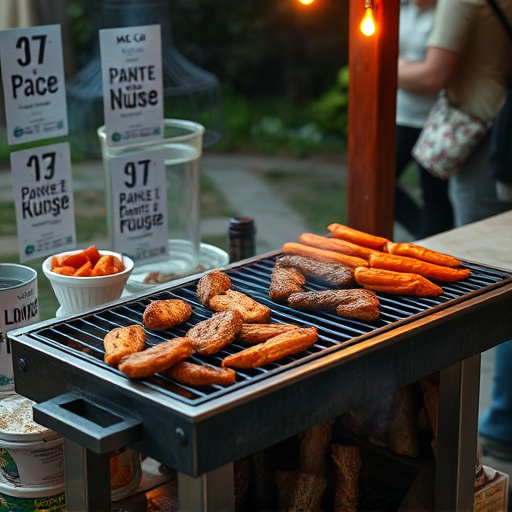
After slow-cooking your BBQ brisket recipe to perfection, it’s time to unlock an extra layer of flavor. Charring the meat adds a smoky depth that takes your brisket from good to great. This process involves searing the surface of the meat over high heat, allowing the exterior to caramelize and develop a crispy, charred crust. The key is to use direct heat, either on a grill or in a pan, for a short burst of intense heat.
The finishing touches are crucial in enhancing your BBQ brisket recipe. Once charred, let the meat rest briefly to allow the juices to redistribute. This simple step ensures a tender, juicy brisket that melts in your mouth. You can also consider adding finishing spices or a drizzle of sauce for an extra touch of flavor, creating a symphony of textures and tastes that will impress any BBQ aficionado.
Resting and Slicing: Ensuring a Juicy, Flaky Brisket
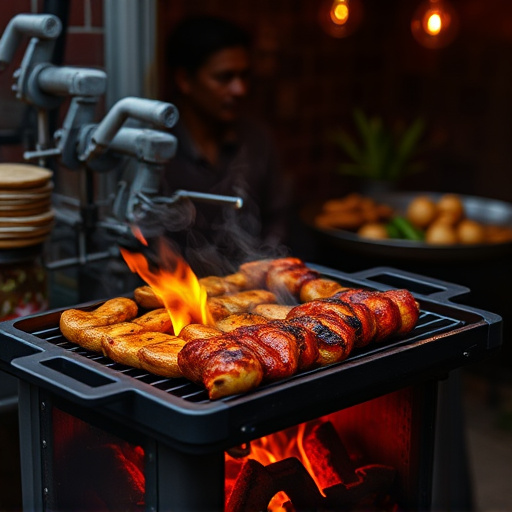
After slowly cooking your brisket to perfection, the next crucial step is resting and slicing. This rest period allows the juices to redistribute throughout the meat, ensuring a juicy and flavorful final product. During this time, the collagen in the meat breaks down, transforming into gelatin, which makes the brisket tender and flaky.
When slicing, go against the grain of the meat to achieve maximum tenderness. This technique ensures that each slice is packed with flavor and moisture. Proper resting and slicing not only enhance the overall dining experience but also showcase your barbecue skills, making it a standout element in any BBQ brisket recipe.
